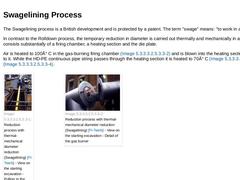
|
The Swagelining process is a British development and is protected by a patent. The term "swage" means: "to work in a die". In contrast to the Rolldown process, the temporary reduction in diameter is carried out thermally and mechanically in a die. This consists substantially of a firing chamber, a heating section and the die plate. Air is heated to 100° C in the gas-burning firing chamber (Bild 5.3.2.2.1.4.2.2) and is blown into the heating section … |
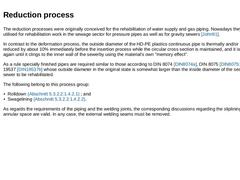
|
The reduction processes were originally conceived for the rehabilitation of water supply and gas piping. Nowadays they are also utilised for rehabilitation work in the sewage sector for pressure pipes as well as for gravity sewers [John91]. In contrast to the deformation process, the outside diameter of the HD-PE plastics continuous pipe is thermally and/or mechanically reduced by about 10% immediately before the insertion process while the circular … |
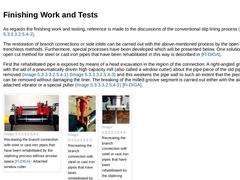
|
As regards the finishing work and testing, reference is made to the discussions of the conventional slip lining process (Bild 5.3.2.2.1.1). The restoration of branch connections or side inlets can be carried out with the above-mentioned process by the open cut and the trenchless methods. Furthermore, special processes have been developed which will be presented below. One solution using the open cut method for steel or cast iron pipes that have been … |
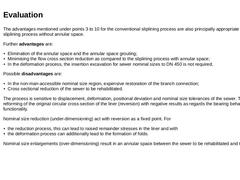
|
The advantages mentioned under points 3 to 10 for the conventional sliplining process are also principally appropriate for the sliplining process without annular space. Further advantages are: - Elimination of the annular space and the annular space grouting;
- Minimising the flow cross section reduction as compared to the sliplining process with annular space;
- In the deformation process, the insertion excavation for sewer nominal sizes to DN 450 is not …
|
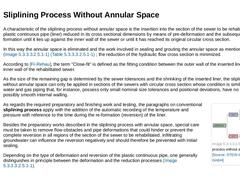
|
A characteristic of the sliplining process without annular space is the insertion into the section of the sewer to be rehabilitated of a plastic continuous pipe (liner) reduced in its cross sectional dimensions by means of pre-deformation and the subsequent re-formation until it lies up against the inner wall of the sewer or until it has reached its original circular cross section. In this way the annular space is eliminated and the work involved … |
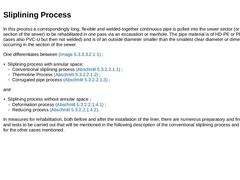
|
In this process a correspondingly long, flexible and welded-together continuous pipe is pulled into the sewer sector (or at least one section of the sewer) to be rehabilitated in one pass via an excavation or manhole. The pipe material is of HD-PE or PP (in individual cases also PVC-U but then not welded) and is of an outside diameter smaller than the smallest clear diameter or dimension occurring in the section of the sewer. One differentiates between (… |
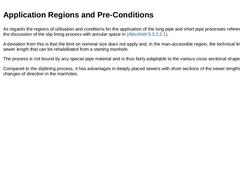
|
As regards the regions of utilisation and conditions for the application of the long pipe and short pipe processes reference is made to the discussion of the slip lining process with annular space in Abschnitt 5.3.2.2.1. A deviation from this is that the limit on nominal size does not apply and, in the man-accessible region, the technical limitation of sewer length that can be rehabilitated from a starting manhole. The process is not bound by any special … |
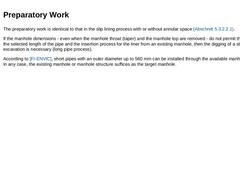
|
The preparatory work is identical to that in the slip lining process with or without annular space (Abschnitt 5.3.2.2.1). If the manhole dimensions - even when the manhole throat (taper) and the manhole top are removed - do not permit the insertion of the selected length of the pipe and the insertion process for the liner from an existing manhole, then the digging of a starting excavation is necessary (long pipe process). According to [FI-ENVIC], short … |
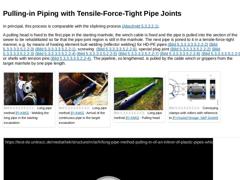
|
In principal, this process is comparable with the sliplining process (Abschnitt 5.3.2.2.1).
A pulling head is fixed to the first pipe in the starting manhole, the winch cable is fixed and the pipe is pulled into the section of the sewer to be rehabilitated so far that the pipe joint region is still in the manhole. The next pipe is joined to it in a tensile-force-tight manner, e.g. by means of heating element butt welding (reflector welding) for HD-… |
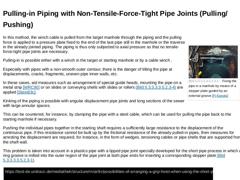
|
|
|
|
|
|
(Image: Fixing the pipe in a manhole by means of a stopper plate guided by an external groove [FI-Egepla]) |
In this method, the winch cable is pulled from the target manhole through the piping and the pulling force is applied to a pressure plate fixed to the end of the last pipe still in the manhole or the traverse in the already jointed piping. The piping is thus only subjected to axial pressure so that no tensile-force-tight pipe joints are … |
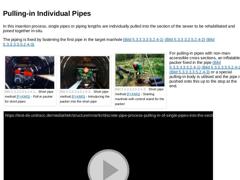
|
In this insertion process, single pipes or piping lengths are individually pulled into the section of the sewer to be rehabilitated and joined together in-situ.
The piping is fixed by fastening the first pipe in the target manhole (Bild 5.3.2.2.2.4.1.3) (Bild 5.3.2.2.2.4.1.3) (Bild 5.3.2.2.2.4.1.3). |
|
(Image: Short pipe method [FI-KMG] - Pull-in packer for short pipes) |
(Image: Short pipe method [FI-KMG] - Introducing the packer into the short pipe) |
|
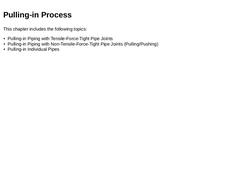
|
|
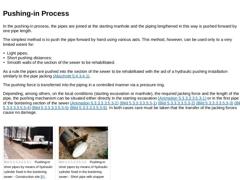
|
In the pushing-in process, the pipes are joined at the starting manhole and the piping lengthened in this way is pushed forward by one pipe length.
The simplest method is to push the pipe forward by hand using various aids. This method, however, can be used only to a very limited extent for: -
Light pipes;
-
Short pushing distances;
-
Smooth walls of the section of the sewer to be rehabilitated.
As a rule the pipes are pushed into the section of the … |
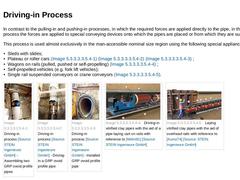
|
In contrast to the pulling-in and pushing-in processes, in which the required forces are applied directly to the pipe, in the drive process the forces are applied to special conveying devices onto which the pipes are placed or from which they are suspended. This process is used almost exclusively in the man-accessible nominal size region using the following special appliances: - Sleds with slides;
- Plateau or roller cars (Bild 5.3.2.2.2.4.3) (Bild 5.3.2.2.2.4.3)
|
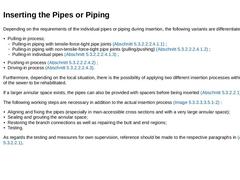
|
Depending on the requirements of the individual pipes or piping during insertion, the following variants are differentiated [Stein83c] : - Pulling-in process;
- Pulling-in piping with tensile-force-tight pipe joints (Abschnitt 5.3.2.2.2.4.1.1) ;
- Pulling-in piping with non-tensile-force-tight pipe joints (pulling/pushing) (Abschnitt 5.3.2.2.2.4.1.2) ;
- Pulling-in individual pipes (Abschnitt 5.3.2.2.2.4.1.3) ;
- Pushing-in process (Abschnitt 5.3.2.2.2.4.2) ;
|
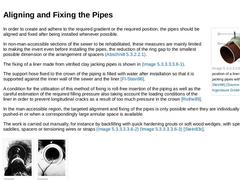
|
(Image: Securing the position of a liner of vitrified clay jacking pipes with reference to [FI-Stein96] [Image: S&P GmbH]) In order to create and adhere to the required gradient or the required position, the pipes should be aligned and fixed after being installed whenever possible. In non-man-accessible sections of the sewer to be rehabilitated, these measures are mainly limited to making the invert even before installing the pipes, the reduction of … |
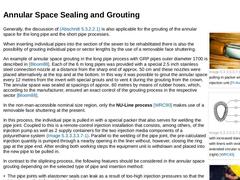
|
|
(Image: Special pulling-in packer with coupled injection unit [FI-Avent])
|
|
(Image: Regions with increased danger of buckling with liners with ovoid (left) and extended circular cross section (right) [WRC83])
|
|
(Image: Liner of short pipes with injection pipes placed on top for grouting the annular space and as spacers)
|
Generally, the discussion of Abschnitt 5.3.2.2.1 is also applicable for the grouting of the annular space for the long pipe and … |
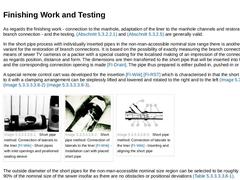
|
As regards the finishing work - connection to the manhole, adaptation of the liner to the manhole channels and restoration of the branch connection - and the testing, Abschnitt 5.3.2.2.1 and Abschnitt 5.3.2.5 are generally valid. In the short pipe process with individually inserted pipes in the non-man-accessible nominal size range there is another special variant for the restoration of branch connections. It is based on the possibility of exactly … |
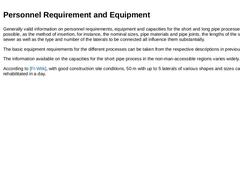
|
Generally valid information on personnel requirements, equipment and capacities for the short and long pipe processes are not possible, as the method of insertion, for instance, the nominal sizes, pipe materials and pipe joints, the lengths of the sections of the sewer as well as the type and number of the laterals to be connected all influence them substantially. The basic equipment requirements for the different processes can be taken from the respective … |
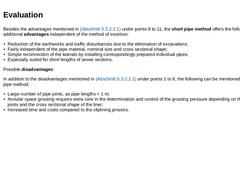
|
Besides the advantages mentioned in Abschnitt 5.3.2.2.1 under points 8 to 11, the short pipe method offers the following additional advantages independent of the method of insertion: - Reduction of the earthworks and traffic disturbances due to the elimination of excavations;
- Fairly independent of the pipe material, nominal size and cross sectional shape;
- Simple reconnection of the laterals by installing correspondingly prepared individual pipes;
- Especially …
|
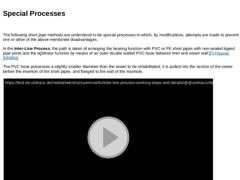
|
The following short pipe methods are understood to be special processes in which, by modifications, attempts are made to prevent one or other of the above-mentioned disadvantages.
In the Inter-Line Process, the path is taken of arranging the bearing function with PVC or PE short pipes with non-sealed lipped pipe joints and the tightness function by means of an outer double walled PVC hose between liner and sewer wall [FI-Haywa] [NN88a].
The PVC hose … |
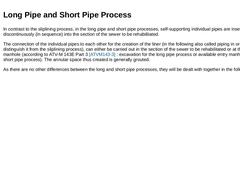
|
In contrast to the sliplining process, in the long pipe and short pipe processes, self-supporting individual pipes are inserted discontinuously (in sequence) into the section of the sewer to be rehabilitated. The connection of the individual pipes to each other for the creation of the liner (in the following also called piping in order to distinguish it from the sliplining process), can either be carried out in the section of the sewer to be rehabilitated … |
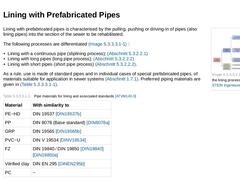
|
(Image: Distribution of the lining processes) Lining with prefabricated pipes is characterised by the pulling, pushing or driving-in of pipes (also lining pipes) into the section of the sewer to be rehabilitated. The following processes are differentiated (Bild 5.3.2.2) : - Lining with a continuous pipe (sliplining process); (Abschnitt 5.3.2.2.1)
- Lining with long pipes (long pipe process); (Abschnitt 5.3.2.2.2)
- Lining with short pipes (short pipe process) (…
|
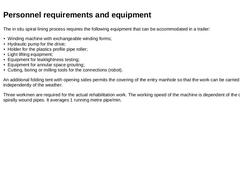
|
The in situ spiral lining process requires the following equipment that can be accommodated in a trailer: - Winding machine with exchangeable winding forms;
- Hydraulic pump for the drive;
- Holder for the plastics profile pipe roller;
- Light lifting equipment;
- Equipment for leaktightness testing;
- Equipment for annular space grouting;
- Cutting, boring or milling tools for the connections (robot).
An additional folding tent with opening sides permits the covering … |
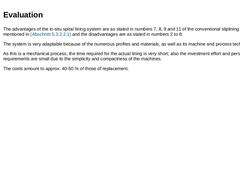
|
The advantages of the in-situ spiral lining system are as stated in numbers 7, 8, 9 and 11 of the conventional sliplining process mentioned in Abschnitt 5.3.2.2.1 and the disadvantages are as stated in numbers 2 to 8. The system is very adaptable because of the numerous profiles and materials, as well as its machine and process techniques. As this is a mechanical process, the time required for the actual lining is very short; also the investment effort … |